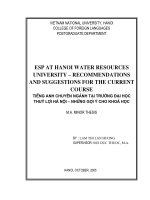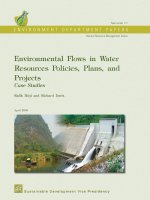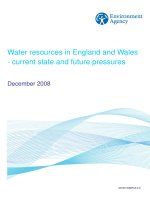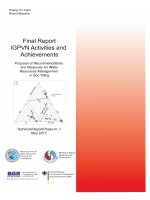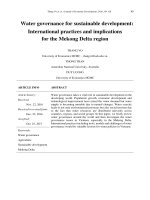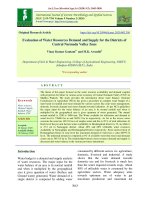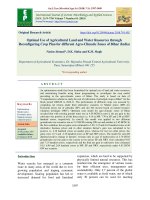Esp at hanoi water resources university – recommendations and suggestions for the current course
Bạn đang xem bản rút gọn của tài liệu. Xem và tải ngay bản đầy đủ của tài liệu tại đây (257.09 KB, 60 trang )
!""#
I certify my authorship of the Field Study Report submitted today entitled
in terms of the Statement of Requirement for Theses and Field Study Reports in Masters’
Programmes issued by the Higher Degree committee.
Lam Thi Lan Huong
!"##$
%&
This Field Study Report has come to fruition as the combination of
knowledge drawn from all the lectures, reading, and discussion with friends
during my M.A. course (TESOL) at the Postgraduate Department at the
College of Foreign Languages, Vietnam National University. Therefore, I
would like, first of all, to express my gratitude to all my lecturers at the
College.
I wish to acknowledge the support and encouragement of the Postgraduate
Department, especially Mr. Le Hung Tien, the Director of the Department
I would like to emphasize the fact that I am indebted to Mr. Bui Duc Thuoc,
my supervisor for his valuable guidance, criticism, comments, correction
and for his kind encouragement during the development of this study. His
suggestions and recommendations, genuine interest, endurance, patience in
editing this thesis are highly appreciated.
I am grateful to the leaders of Hanoi Water Resources University, especially
Professor Le Kim Truyen, our Rector for granting me the scholarship and
time for the thesis. Without their support and assistance this study could not
have been completed.
My thanks also go to my colleges at Hanoi Water University, especially Mr
Le Van Khang, Dean of Department, for their encouragment and
understanding.
Finally, this thesis is dedicated to 210 students at Hanoi Water University for
their time, patience and cheerful acceptance of the task of completing the
questionnaires and those who have kindly advised and helped me towards
the completion of my research.
%
This research study was carried out with an attempt to answer the question “ What is the
learners’ evaluation of the current ESP course at Hanoi Water Resources?”
In order to achieve the aims of the study the following specific objectives
were established:
- Firstly, to find out what the learners think of the current ESP course with
reference to their needs and interests.
- Secondly, to find out the learners’ comments on the course organisation;
- Thirdly, to offer some suggestions and recommendations for the improvements of
the course to make it more relevant to the learners’ needs and interests.
The results of the study show that the learners at HWRU find the ESP course
useful and relevant to their subject matter although they are not satisfied
with the course very much. The study suggests that in order to bridge such a
gap it is necessary to develop ESP materials, to improve some classroom
techniques and to train our students to become active learners.
'
:
1.1. Rationale 1
1.2. Aims and objectives of the study 1
1.3. The background and the scope of the study 2
1.4. The significance of the study 2
1.5. Methodology 2
1.6. The design of the study 2
2.1. An overview of ESP 3
2.1.1. How ESP is understood? 3
2.1.2. Types of ESP 5
2.2.3. Linguistic features of register in Water Resources 6
2.2. Material and course evaluation 9
2.2.1. Why course evaluation 10
2.2.2. Material and course evaluation framework 11
2.2.3. Criteria for material and course evaluation 14
2.3.4. Learners as course evaluators 16
3.2. The teaching and learning situation at HWRU 17
3.3. Resources and Administrative constraints 18
3.4. The target students 18
3.5. The teaching staff of English session 19
:
4.1. Research methodology 21
4.1.1. Subjects of the study 21
4.1.2. Instruments 21
4.2.Data analysis and discussions 22
4.2 1. Learners’ ranking of the purposes in learning ESP 22
4.2.2. Learners’ evaluation of the current ESP course 23
4.2.3. Learners’ evaluation of the ESP classroom activities 27
4.2.4. Learners’ wants and needs of the ESP course 31
4.3. Conclusion 32
:
5.1. Summary of the findings 34
5.2. Recommendations and suggestions for the teaching and learning
ESP at HWRU. 34
5.2.1. Developing ESP material 34
5.2.1.1. Developing topics 34
5.2.1.2. Adapting practice exercises 35
5.2.1.3. Improving the layout of the material 36
5.2.2. Improving teachers’ classroom techniques 37
5.2.2.1. Adjusting teaching time and efforts 37
5.2.2.2. Solving the problems 37
5.2.3. Training students to become active readers by encouraging their
extensive reading habits 39
5.2.4. Summary 40
41
Reference
!"!#$%
I.1. Rationale of the study
The ongoing process of regional and global integration in Vietnam has resulted in
an increasing demand for English language teaching across the country. Students in
universities are taught English with a considerable length of time. Some of the graduates
are able to use English in their work: reading documents, writing articles or reports,
communicating or attending international conferences… However, some others who also
have certificates or degrees find it hard to use it in their daily work. It should be noted
that the syllabuses for non – gifted students at these universities have not brought real
effects for learners. Therefore, the quality of English training courses doesn’t often come
up to the expectation.
English has been taught to undergraduates of Hanoi Water Resources University
for many years. As a technical university, one of the requirements for graduates is to be
able to read professional documents in their fields for further study, or future jobs.
Therefore, ESP was first introduced into the syllabus nearly ten years ago. However, the
current course is not well – received by the learners because of its failure to match their
needs, interests, and learning preferences. This reality makes it necessary to have the
course evaluated by the learners. If appropriate, modifications are to be necessary made
for the improvement of the course quality.
I.2. Aims and objectives of the study
In this field study, an answer to my research questions: “ What is the students’
evaluation of the current ESP course at Hanoi Water Resources University?” is
intensively sought.
The major aims of this study are:
To identify what the students think about the current ESP course, the inadequacies
in terms of the course content and delivery methods of the course with reference
to the learners’ needs and expectations.
From the findings, hopefully the teachers at HWRU will be informed of how to
improve the course by making the course more appropriate to learners’ needs and
raising the quality of ESP teaching at HWRU.
In order to achieve the aims of the study, the following objectives and activities were
established:
Firstly, to find out the learners’ opinion on the current teaching material with
reference to their needs and interests.
Secondly, to find out what learners think about the time allocation and the
delivery method of the course.
Thirdly, to offer some suggestions and recommendations for the improvement of
the course to make it an effective course for learners.
I.3. The scope of the study:
This study is to provide information on Hanoi Water Resources students’
evaluation of the current ESP course. The information is intended to be used as the base
for improving the current ESP course at HWRU, making the course more effective.
Also, the findings from this study will help ESP teachers at the college meet the
learners’ expectation by narrowing the gap between teaching and learning. Any other
purposes would be beyond the scope of the study.
I.4. Method of the study
In order to achieve the above-mentioned aims and to make my thesis both
academic and practical, data were collected by means of survey questionnaires and then
analyzed quantitatively. The survey was done on 210 Learners in their second year at
HWRU to investigate their evaluation of the current English for Specific Purpose course.
Beside the survey, more information needed in the process of materials selection
has been gathered from document analysis.
I.5. The design of the study
The study is comprised of four chapters:
Chapter One, the introduction, provides information on the background, the scope, the
significance and the aims of the study.
Chapter Two reviews the literature related to ESP, material and course evaluation. This
literature review is aimed at establishing a theoretical background for evaluating and
adapting material.
Chapter Three presents an overview of ESP at HWRU, and then devotes to the research
methodology and data analysis.
Chapter Four presents the summary of the findings and some recommendations and
suggestions for the current ESP course at HWRU.
Chapter Two(
))*+*%
II.1.1. How ESP is understood?
ESP has been defined with different emphasis on a variety of elements that
characterizes ESP. Different researchers and scholars have different views of what it is
that counts in ESP.
First, Fitzjohn in Robinson (1980:9) takes the time factor as a characteristic
feature of ESP. He notes:
“ The very concept of “ special purposes” implies that foreign language study is a
subsidiary contribution to another, main interest, and that there will normally be pressure
to achieve the required level of linguistic competence in a minimum of time”.
When Fitzjohn considers ESP as a subsidiary contribution to another main
interest, he focuses on ESP as having an immediate, utilitarian purpose, not simply
pleasure, or a long-term purpose. There is usually a very clearly specified time period for
the course. This means that objectives should be closely specified and their realization to
the timetable. This also requires the collaboration of those involved in the course:
organizers, teachers, sponsors, and learners.
Second, the age of the learners is also a criterion of ESP. Most of ESP learners are
likely to be adults, not children. Normally, they are students in tertiary education or
experienced members of the workforce. In this regard, Robison cited in Long (1980:9)
points out: “ By and large these people have been students in tertiary education, and
adults”.
Because the learners are adults, their background knowledge and their way of
learning are quite different from those of children. For example, adult learners often learn
by “problem solving” not by mimicry or repetition which young children enjoy. For this
reason, in teaching an ESP course, the teacher should take the learner’s age into account
so as to find out appropriate materials and methods of teaching to suit the age of the
learners.
Thirdly, the learners’ needs are considered the most important factor in ESP.
Brumfit (1997:7) states that:
“ First, it is clear that an ESP course is directly concerned with the purposes for
which learners need English, purposes for which are usually expressed in functional
terms. ESP fits firmly within the general movement towards ‘ communicative’ teaching
of the last decade or so”.
Many researchers (for example Kerr, 1977; Munby, 1978) take Brumfit’s above
position that need analysis should be conducted prior to course design and material
development or selection. For them, not only the syllabus, the materials, but also teaching
methodology should be adapted to the needs of the learners. Strevens (1988:1) also
produces a definition that covers more detailed characteristics of an ESP course. He states
that:
“ ESP is a particular case of the general category of special - purpose language
teaching. The same principles apply no matter which language is being learnt and taught.
French for specific purposes, Russian for specific purposes, Chinese for specific purposes
– all of these exist and are constructed on the same basis as English for specific purposes.
The vastly greater demand for English makes ESP more common that FSP, RSP or CSP,
but the principles are the same”.
From the above definition, Strevens goes on to maintain that in defining ESP,
there needs to be a distinction between absolute characteristics and variable one. The
absolute characteristics of ESP are as follows:
ESP consists of English language teaching that is:
Designed to meet specified needs of the learners.
Related in content (i.e. in its themes and topics) to particular disciplines,
occupations and activities.
- centered on the language appropriate to those activities, in syntax, lexis,
discourse, semantics, etc.
- In contrast with “ GE”
According to him, ESP may, but not necessarily be characterized as being:
- Restricted as to the language skills to be learnt (e.g. reading only, speech
recognition only, etc )
- taught according to any pre-ordained methodology (i.e. ESP is not restricted to
any particular methodology - although communicative methodology is very often
felt to be the most appropriate).
It is noteworthy that those definitions imply two factors: (1) the broad meaning of the
term ‘purpose’ and (2) the syllabus basing on learners’ needs analysis to determine the
content of the syllabus, the materials and methods of teaching / learning for these
purposes.
With specific purposes in mind, the learners know clearly what they need to learn,
and they will learn with high motivation what they find useful for their work later, or at
present. For this reason, an ESP teacher should be aware of the learners’ needs so as not
to introduce irrelevant materials to the course.
II.1.2. Types of ESP
There are many types of ESP, but the major distinction is often drawn between EOP
(English for Occupational Purposes), and EAP ( English for Academic Purposes), and
EST (English for Science and Technology).
Strevens ( 1977 cited in Munby, 1978:55) made a classification of various types of
ESP in the following figure:
Simultaneous
Post - experience
Occupational
( EOP )
Pre - study
In - study
Post - study
Educational
( EEP )
Other
ESP
According to Munby ( 1978: 55), ESP could be divided into two broad areas:
English for Occupational Purposes (EOP) ‘where the participant needs English to
perform all or part of his occupational duties’ and English for Educational Purposes (
English for Academic Purposes or EAP) ‘ where the participant needs English to pursue
part of his studies’. EOP, therefore, can include both pre-experience and post-experience
ESP. However, Hutchinson and Waters ( 1987) claimed that there is no clear-cut
distinction between EOP and EAP as people can work and study simultaneously and in
many cases the language learnt for immediate use in a study environment will be used
later when the students take up, or return to a job.
Apart from the occupational / educational dichotomy which can be found in most
classifications of ESP, Strevens ( 1977 cited in Munby, 1978) defined that those learners
whose purposes are concerned with science and technology are usually referred to EST. It
differs from other courses in that it possesses a set of features that characterizes
‘scientific English’ including the linguistic rules for creating scientific text, the
terminology of the particular scientific purposes appropriate to an EST course and the
purposes of science. Courses that do not possess these features are called ‘other ESP’.
In fact, Strevens distinguishes the learner who learns English before he studies his
discipline from the learner who learn English while he is studying or after he has studied
the discipline. This distinction is very important because learners’ experience has a great
influence on his progress in study as well as the materials and method used in a course.
Thus, the content of an English program for someone actually engaged, for example, on a
secretarial with its acquisitions for practical skills and theoretical knowledge is going to
be different from a program for someone who is already a qualified secretary but now
needs to operate in English.
II.3.1. Linguistic features of register in Water Resources
Various researchers (notably Swales, 1990; Hopkins and Dudley-Evans, 1988;
Thompson, 1993) have shown very convincingly that there is a general pattern of
organization that predominates in the different section of an article or thesis from any
discipline, but there is also variation between different disciplines. Writing in the areas of
science and technology has, however, remained more strongly constrained by academic
discourse convention and expectations of the relevant discourse communities.
English for Water Resources is by no means out of the track. The study of the
lexicon of EWR writing has been conducted generally on three levels:
1. Ordinary vocabulary / core vocabulary
2. Technical vocabulary
3. intermediary (sub- or semi-technical) vocabulary
The first level includes ordinary content words, conjuncts and connectives. The second
level includes the language of taxonomy ( lexis with Latin and Greek roots required for
the classifying of the infinite variety of natural phenomena) and the language of
mathematical operations ( lexis as in mass, force, energy, required for the compounding
of simple concepts into complex ones by clearly prescribed rules
The third level may not prove difficult if the borrowed words from non-technical
spheres as “ long-span structure”, “head loss”, “flood irrigation”, “seasonal flow”…
have been studied at the source. Two factors are involved in the study of scientific words
(1) frequency and (2) presence/absence. In subjects like Water Resources whose concept
and content change rapidly, word frequencies do not remain stable. They change over a
period of time. Words, representing new concepts, new phenomena, rise sharply from
zero frequency (or rarity) to high frequency. But these may decline as interest shifts away
from their focal point. Thus words like “ deforestation”, “ ozone layer”, “greenhouse
effects” or “titanic waves” do not feature in books written several decades ago, but now
they have achieved high-frequency status in most texts on water resources.
Frequency counts of water resource words of the three levels mentioned cannot be
said to be complete or useful unless the following factors are included in the frequency
measurement:
1. defined semantic contexts
2. circumstances of defined formality
3. particular collocations
4. date of publication of texts
5. size and coverage of writer’s vocabulary
Scientists speaking to other scientists in specialist papers use a much smaller
vocabulary than when they write for an undergraduate readership, where explanations
have to be made clear to the less-informed.
It should also be noted that water resource words constantly undergo ‘a process of
semantic erosion’ so that words with highly specific meanings like ‘force’ and ‘energy’
in a water resource discourse become ambiguous. Take, for example, words like
‘generally’, or ‘factor’ in hydraulic construction. The word ‘generally’ has a unique
significance in math and logic. If a proof is a ‘general proof”, it means that the
proposition is ‘generally’, i.e. in all circumstances, true. But the popular concept of this
word is as a synonym for ‘usually’, or ‘in some circumstances’. The word ‘factor’ in the
context of computer or mathematics means a divisor, which leaves no remainder, but we
use it to mean component, aspect, circumstance, or cause. ‘Principle’ in water resource is
an exact scientific concept, but the meaning as ‘rule’ is likely to confuse science learners.
In the early days of ESP, register analysis led to conclusion about which verb
forms and tenses predominated in scientific and technical English. The main conclusion
by Barber (reported in Swales, 1988) was that “ any grammatical work done on the verb
in EAP should concentrate on the present simple, active and passive voice and the modal
verbs”. In water resource texts, however, frequency counts may produce results as shown
in table below.
Section Tense Predominantly Used
Introduction
Method
Discussion/Conclusion
Present simple (active and passive), present perfect
Present passive
Results: past
Comments: present
The idea that scientific or academic writing uses the passive voice more frequently
than the active is a myth; what is true is that such writing uses the passive voice more
frequently than some other types of writing. In hydraulic texts, it is counted that
approximately 60 per cent of the verbs were in the passive voice and 40 per cent in the
active. It seems that the choice of active or passive is constrained by functional
considerations; writers tend to use passive voice when standard procedures are being
described.
“ Earth dams can be classified into plain earth dams, in which the bulk of the dam
body (more than 50%) is composed of small size clayey, sandy or sandy-gravely soils;
rock and earth-fill dams, in which the bulk of the dam body is composed of large-size
gravelly-pebble soils or rock mass, and the antiseepage device is made from small-size
material; soil rock-fill (stone) dams, in which the body of dam, like in rock and earth-fill
dams, is made of large-size material and the antiseepage device, if need be, from other
than earth materials”.
Nominalization is a major feature of abstract language favoured by academic
writers ( Mason, 1990) and it is also a major feature in WRU texts. This use of
nominalization enables complex information to be packaged into a phrase that is simple
from a grammatical point of view and that can be picked up in the theme of the following
sentence.
“ Coastal land reclamation is a traditional form of agricultural development in
our country. The sea-dyke embankment and land expansion toward the sea are processes
happening always at the estuary regions and forming newly-reclaimed areas, which have
good conditions for economic development (agriculture, aquaculture and breeding of sea
products).
In the above example, the norminalised phrases are used frequently. This leads to
another feature in EWR which is syntax. The question of how syntactic structure reflects
content or conceptual structure, and how the former affects comprehension, is of crucial
importance within a theory of EST. There is mounting evidence that the language
complexity reflects a corresponding complexity of content. The usual stereotyped
observation of syntactic characteristics of scientific prose is that it is excessively
dependent on passivization, nominalization, and apposition. And these phenomena
happen excessively in EWR texts.
In short, English for Water resources shares the same linguistic features of
register with other disciplines in EST except for the fact that passivization is so widely
used in most of the WR texts.
))*"*,
According to Hutchinson and Waters (1987:97), textbook evaluation is basically a
straightforward, analytical “ matching process: matching needs to available solutions”.
Evaluation can be obtained not only from course designers, material writers, teachers, but
also from learners. The material writers or teachers can learn a lot in term of ideas and
techniques from evaluating existing materials and analyzing learners’ feedback on the
existing textbooks. Similarly, writing materials makes us more aware of what to look for
in material written by other people – and also more sympathetic to the efforts of other
material writers.
Tony Dudley-Evans and Maggie Jo St John (1998:128) suggest that “ evaluation
is a whole process which begins with determining what information to gather and ends
with bringing about change in current activities or influencing future ones”. They also
believe that “ evaluation must be more than collecting and analyzing data: to have value
the evaluation process must include action”. From this definition, it is clearly seen that
evaluation can be very threatening; it suggest change and change is often resisted. The
threat is greater when evaluation is seen as an imposed external act, over which there is
no control. In fact, evaluation is a very constructive and powerful activity and a very
stimulating one.
Mc. Dounough and Shaw (1993) suggest that teachers begin with an “external
evaluation” which consists of an examination of the claims made on the cover of the
student’s and teacher’s book, the introduction and the table of contents. This, they
suggest, should be followed by a closer and more detailed “ internal evaluation” which
requires an intensive investigation into at least two units of the book or set of materials to
investigate such aspects as a presentation of skills in the material, the grading and
sequencing of material, the kinds of texts used and the relationship between exams and
tests.
Tomlison (1998) affirms that material evaluation is the systematic appraisal of the
value of materials in relation to their objectives and to the objectives of the learners using
them”. According to him material and course evaluation can be:
Pre-use, therefore, focused on predictions of potential value;
Whilst-use, therefore focused on awareness and description of what the learners
are actually doing whilst the materials are being used;
Post-used, therefore, focused on analysis of what happened as a result of using the
materials.
The author mentioned above seems to focus on defining material evaluation
according to the different stages of work. However, the evaluation suggested by Tony
Dudley-Evans and Maggie Jo St John (1998) as well as Mc. Dounough and Shaw (1993)
mainly concerning evaluating the materials before and whilst using, therefore, does not
cover the concept of material evaluation as fully as the definition of Tomlison (1998),
which we in this research would like to follow.
II.2.1. Why course evaluation
Evaluation plays an important role in the improvement of a language program. In any
kind of evaluation, all the important variables should be checked systematically for the
decision finally made and the results of an evaluation will probably have certain impact
on the course itself and on the teachers and learners as well. On the positive side, it can
also help in justifying requests to sponsor or other members of a team for money to buy
materials or time to write them.
To be an integral part of a course, evaluation has to be built in as a part of the course
design. To evaluate everything is unrealistic; priorities can be set, the type of timing of
data collection can be planned together with the resulting actions.
While evaluating the resources available not only once have we wondered which
out of a number of possibilities can represent the best solution. Before answering the
question of “why it is necessary to evaluate materials?” it should be borne in our mind
that “ evaluation is concerned with relative merit. There is no absolute good or bad; only
degrees of fitness for the required purpose” ( Hutchinson and Waters, 1987: 96).
Williams (1983) claims that no textbook can be completely useful to all teaching
situations. In the same view, Nunan (1985: 51) maintains that:
“ Evaluation is the systematic collection and analysis of all relevant information
necessary to promote the improvement of a curriculum and access its effectiveness and
efficiency as well as the participants’ attitudes within the context of the particular
institution involved.
Hutchinson and Waters (1987: 97) clarify their position that there will probably
be a large investment of money in a published course or a large investment of time in
home-produced or adapted materials. Once such an investment is made, one will
probably have to live with the consequences of it for some time, even if it later proves to
have been a bad choice. A careful evaluation, then, can save a lot of expense and
frustration.
With any language course the course itself and the learners’ performance are
necessarily assessed. The results of the evaluation helps to assess whether the course
works as what it was designed to do, enables teachers and learners to decide whether to
use the materials again and how much adaptation and amendment is required to make the
materials more useful. This takes on a greater importance in ESP, because ESP is
concerned with performance of particular communicative tasks.
II.2.2. Material and course evaluation framework
The literature on the subject of textbook evaluation is not very extensive. Various
writers have suggested ways of helping teachers in particular to be more sophisticated in
their evaluative approach, by positing “checklists” based on supposedly generalizable
criteria. These sometimes elaborate system use of a variety of “scoring” methods to
assess how well specific textbooks measure up under scrutiny.
Cunningsworth (1984) seems to make it easier for evaluators in practice by
arranging the evaluation process in a framework of nine small and detailed steps as
follow:
1. Briefly state the objectives of the materials.
2. To what extent is it successful in achieving these objectives?
3. Note particular strength.
4. Note particular weaknesses.
5. Is there any notable omissions/ addition?
6. For what types of learning situations are the materials suitable?
7. For what types of learning situations are the materials unsuitable?
8. Compare with any other materials evaluated
9. General conclusion
Hutchinson and Waters (1987) divide their materials evaluation process into four
major steps:
Defining criteria
Subjective analysis
Objective analysis
Matching
Figure 2: the material evaluation process by Hutchinson and Waters (1987)
The framework is rather easy to follow in practice but what we do having seen the
degree of fitness of the materials is also very important, so this evaluation process would
not be complete without some follow-up action. This is because evaluation is basically a
matching process: matching needs to available solutions. If this matching is to be done as
objectively as possible, it is best to look at the needs and solution separately. In the final
analysis, any choice will be made on subjective grounds. Usually, our choice depends on
what considered to be important. An ESP textbook, for example, has to suit the needs of a
number of parties: teachers, students, sponsors, so it is important that the subjective
factors, which will admittedly play a part, should not be allowed to obscure objectivity in
the early stages of analysis. When commenting on the issue, Littlejohn (1998: 12) says:
-
On what basis will you judge materials?
Which criteria will be more important?
.
What realizations of the criteria
do you want in your course?
.
How does the material being
evaluated realize the criteria?
,
How far does the material
match your needs?
“ A preliminary framework for material and course analysis, evaluation focuses
on a clear distinction between an analysis of the material, an analysis of the proposed
situation of use, the process of matching an evaluation, and subsequent action”
Then evaluation aims to set out precisely which aspects of the materials are
appropriate or inappropriate and why. The final stage involves evaluators in making
decisions on what to do next in the light of matching and evaluation. The procedure of
evaluation is suggested by Littlejohn (1998) to follow the following framework.
Figure 3: A preliminary framework for materials analysis and action by Littlejohn (19
It will be reasonable to make the overview of all the mentioned frameworks of
course evaluation.
the cultural context
the situation
the course (proposed aims,
content, methodology,
measures of evaluation)
the teachers
the learners
$
$$
$
How appropriate are the respects of design and the
aspects of publication to the target situation use
Adopt the materials
Reject the materials
Adapt the materials
Supplement the materials
Make the materials a critical object
From analysis:
1. What is their explicit nature?
2. What is required by users?
3. What is implied by their use?
To description:
aspects of design
aspects of publication
In Cunningsworth’s framework, strength and weaknesses, suitability and
unsuitability were brought into focus to see whether the course objectives are being met.
To make it easy to compare different sets of materials as well as to assess strengths and
weaknesses, suitability and unsuitability, Hutchinson and Waters suggested defining
criteria for evaluation. Evaluating based on the set of criteria helps to see the degree of
fitness for the required purposes as well as how much the course meets the learners’
needs. The most important factor in course evaluation made in Littlejohn’s framework is
the follow-up action. It means that adaptation and adjustments can be carried out for the
improvement of the course.
It can be interpreted from the above processes of material and course evaluation
that despite having different sample frameworks, all the researchers express the same
common ideas which I will apply into this research framework.
It is clearly seen from every evaluation process that the very first step is to define criteria.
The answer will be given in the next section where some literature review on the field
will be made.
-
.
- Objectives of the course
- Students’ needs
- Reality of teaching and
learning
.
- Materials’ objectives
- Content
- Teaching and learning
techniques
,
- Material adaptation
- Content
-
Teaching technique
II.2.3. Criteria for course evaluation:
In a study by Cunningsworth (1984), a long and detailed checklist of evaluation
criteria is presented. His criteria can be summarized in the form of main points
supporting by a number of smaller questions. These points are:
Language context
Selection and grading of language items
Presentation and practice of new language items
Developing language skills and communication abilities
Supporting material
Motivation and learners
The next idea I would like to mention here is given by David Williams (1983).
When introducing the “sample checklist for evaluation”, he notes that it is not meant to
be exhaustive. Items on it, grouped for convenience under logical headings, were
generated in the same way, and teachers can evolve their own sets of criteria for different
educational levels or language teaching situations. (See the appendix 1).
In a closer relation with research’s target situation (evaluating sections / parts of
the book), an article by Sheldon (1988) provides us with textbook evaluation sheet. On
presenting his textbook evaluation sheet, he also believes that “ any culturally restricted,
global list of criteria can never really apply in most local environments, without
considerable modification”(See the appendix 2). He also states that we can be committed
only to checklists or scoring systems that we had a hand in developing, and which have
evolved from specific selection priorities. So we need some points around which our
thoughts can crystallize.
Sharing the same attention to the issue, Mc Dounough and Shaw (1993) bring us
to make an overall assessment as to the suitability of the materials by considering some “
parameters” as follow:
1. The usability factor: how far the materials could be integrated into a particular
syllabus as “core” or supplementing?
2. The generalizability factor: Is there a restricted use of “core” features which
make the materials more generally useful?
3. The adaptability factor: can parts be added / extracted / used in another context /
modified for local circumstances?
4. The flexibility factor: How rigid is the sequencing and grading; can the material
be entered with different points / used in different ways?
All those above authors remind us that their checklist is not an “exhaustive list”
(Hutchinson and Waters, 1987), other evaluators may find other criteria for their own
situation. Here, the idea I got in mind is that all the different sets of criteria mentioned
above are reliable and in practice, each set of the criteria can provide enough evidence to
make clear the degree of fitness of the materials and can be detailed enough for us to
apply into the related work. However, as it has been stated previously, we - evaluators
should consider which of the criteria are of more importance according to our own
situation.
In this section we have looked at materials and course evaluation, criteria for
evaluation as well as the need to develop our own criteria for our own context. In this
case this is an evaluation of ESP program at Hanoi Water Resources University. The
evaluation of existing materials can provide the teachers and material writers here with a
good source of ideas (of what to avoid and what to do) and techniques.
For the target situation of this research, a checklist of the material and course
evaluation criteria has been developed into four criteria inclusively:
the aim
the content and method
needs of the learners
the reality of learning and teaching ESP at HWRU.
II.2.4. Learners as course evaluators
ESP is accountable teaching. Learners who invest in the course want to see the
results of their investment of time or money. Therefore, ESP learners themselves are
responsible for evaluating how appropriate, relevant and useful the course is. Evaluation
from learners reflects not just the learners’ performance but to some extents the
effectiveness or otherwise of the course too. Evaluation of and from learners is unlikely
to indicate exactly where a fault lies, but it will at least indicate the existence of a fault
somewhere. Learners’ evaluation provides feedbacks on the ESP course. Thus, learners
must be seen as course evaluators.
As defined by Sysoyev (2004), “evaluation can be done in two different ways
implicitly and explicitly”. In implicit evaluation which takes place during the semester,
learners play an indirect role. Their grades, their participation and motivation give clues
to the teachers on how their learning is going on and whether the course is doing what it
was designed to do.
Answering questionnaires, taking part in surveys, talks, interview, learners as
direct evaluators together with teachers carry out explicit evaluation which may take
place at the end of the course or after the learners have completed it. The learners express
their attitude toward the subject matter, instructional methods, activities, the teacher’s
role and so on. The learners’ feedbacks provide a good source of ideas of what to avoid
and what to do and techniques so that more appropriate materials and methodology will
be made as well as content and delivery methods will be properly adapted.
Chapter three
This chapter provides background information about ESP at Hanoi Water
Resources University. The information presented here includes the reality of English
language teaching and learning, the learners and teachers’ profile, and a description of the
current ESP course of the University.
III.1. The English teaching and learning situation at HWRU
Until 1990, little attention was paid to the teaching and learning of English at
Hanoi Water Resources University. The dominant foreign language taught at that time
was Russian. Meanwhile, English was only taught at a few classes because at that time
there were only two teachers of English. However, in 1990s, English took over the
dominant position of Russian and became the most popular foreign language to be taught
in the university. Since then, the teaching and learning of English has received greater
attention and interest.
From 1990 to 1999, the time fund for English course was 300 class hours. At that
time, the teachers often concentrated on teaching grammar and vocabulary instead of
speaking and listening. Students, therefore, did not have much practice in the classroom.
Another problem is that the textbooks used are those written to teach General
English, which is not relevant to water resource students. Thus, most of the students find
it difficult to read materials in their specific areas after having finished their English
course at the university.
Since 2000, ESP has been introduced at HWRU. However, due to the limited
time, the students at HWRU can only have 45 periods of learning ESP. The English
program in the university is divided into three stages: Elementary, Pre-intermediate, and
ESP. Some years ago, the time allocated for the first two stages was 255 periods.
However, it has been cut down since 2004 to only 150 class hour. Therefore, the whole
curriculum of English is as follows:
Stage 1: General English with 75 periods
Stage 2: General English with 75 periods
Stage 3: ESP with 45 periods
With such a timeframe, the students cannot learn much but just come to know a
number of technical terms or concepts in English. All the teachers could do is to help
students develop their ESP learning skills with focus on how to read specific document,
how to write letters, contracts or reports, and so on.
)))*"*
In fact, the teaching and learning English at HWRU is affected by some
constraints such as the class size, economic conditions and time allocation. The average
class size is 40-69 students, so it is too crowded for communicative English. Besides,
classrooms are not appropriately arranged for language classes. In fact, they are designed
as lecture halls for other subjects. Therefore, classroom interaction is always in the form
of question and answer. All these constraints have negative effect on the quality of the
English teaching and learning at the HWRU.
Until 2004, the textbooks used for stage one and stage two were “ the New
English Cambridge course 1, 2” and “ Listen carefully” and “Let’s listen” for the students
to listen in the two language labs. In 2005, a new textbook, “ the New Headway course”
has been introduced and simplified by the teachers at the English section. The book has to

